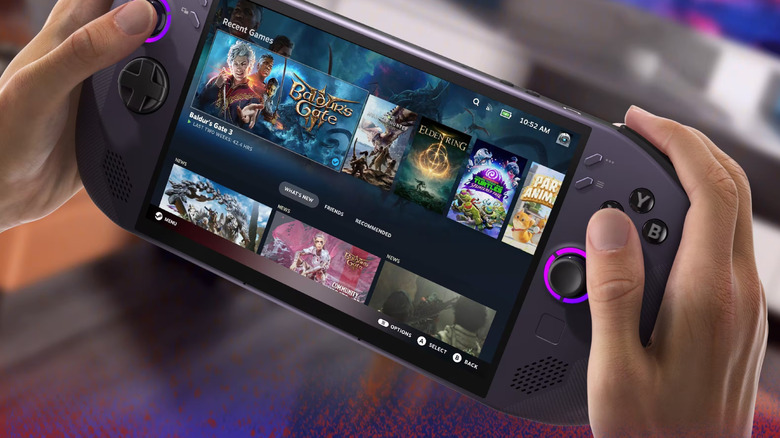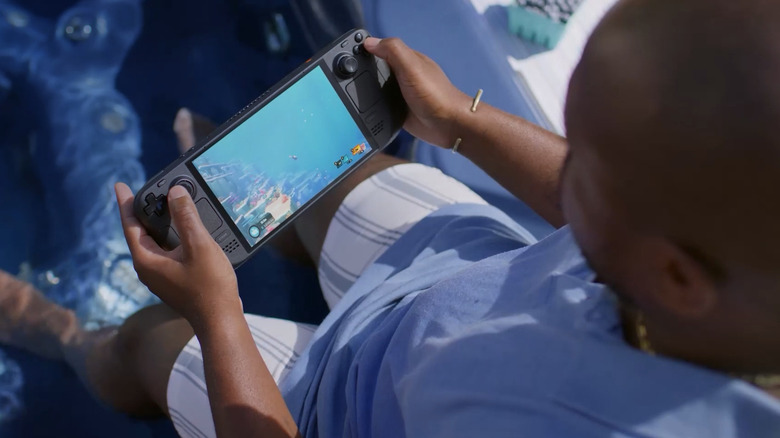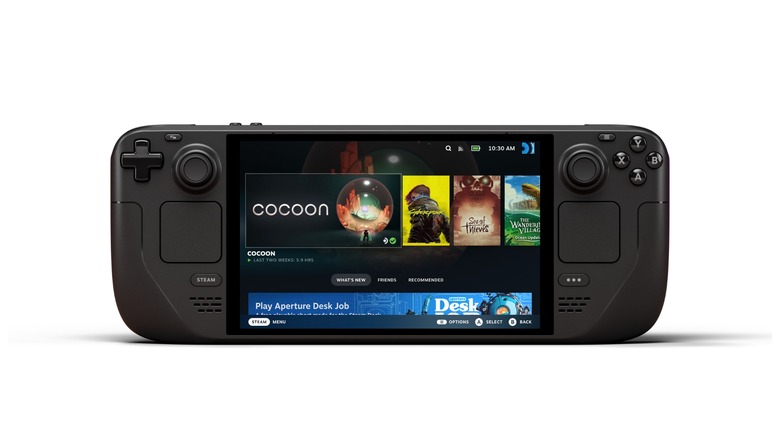Will SteamOS Let You Avoid Windows On Gaming Handhelds?
One of the most delightful gadgets to emerge over the past several years is the handheld gaming PC. Popularized by the Steam Deck, these are essentially tiny Windows computers stuffed into a Nintendo Switch-style form factor, allowing you to play your favorite PC games on the go. However, they've always had one major issue: Windows itself. The operating system is designed for full-size PCs, so replacing a mouse and keyboard with joysticks and a D-pad can be a recipe for frustration. And then there's the battery life, which Microsoft's OS slurps up like a kid with a Capri Sun.
In addition to users, Valve, the maker of the Steam Deck and the ubiquitous Steam app, was clearly frustrated with the state of gaming handhelds on Windows. Given the popularity of the Steam Deck and other handhelds that use Steam on Windows, Valve had a choice: it could suffer the inadequacies forced upon its ecosystem by Windows, or it could leverage its dominance in the PC gaming space to compete directly with Microsoft. It chose the latter, and now SteamOS is here, claiming to solve the headache-inducing mess that gaming on Windows has become.
SteamOS is a Linux-based operating system designed specifically for gaming, and even more specifically for handhelds. To enable game compatibility, it runs non-Linux games through a compatibility layer. The question is whether this actually works better than Windows, and the answer appears to be... absolutely, without question, all hail our new Linux overlords. As of this writing, the first native SteamOS handhelds are hitting the market, and the reception has been overwhelmingly positive. So, including all the most notable capabilities and limitations of the platform, here's how SteamOS can help you avoid Windows on gaming handhelds.
Windows problems require SteamOS solutions
As of this writing, the only handheld gaming devices with official SteamOS support are the Steam Deck and Lenovo Legion Go S, the latter of which comes in both Windows and SteamOS variants. Since people can now compare the same device running both operating systems, we're beginning to understand just how handcuffed handheld gaming has been by the limitations Windows imposes thereupon. As YouTuber Dave2D put it, "Windows was the problem all along."
In SlashGear's review for the Lenovo Legion Go S, our Andy Zahn enjoyed nearly everything about the device aside from Windows 11 and recommended waiting for the SteamOS version. With that version out now, it's clear that not only does SteamOS perform better and enable a longer battery life, it's also cheaper since Valve isn't charging vendors for a SteamOS license like Microsoft does for Windows. In the aforementioned testing from Dave2D, he saw better frame rates from the SteamOS version in four out of five games, and battery life was 35 minutes longer in "Cyberpunk 2077," and a whopping 4 hours and 21 minutes better in "Dead Cells." When you consider that games on SteamOS need to be run through Valve's Proton compatibility layer, those results are even more astonishing.
SteamOS still runs out of steam in some areas
Given all the benefits of SteamOS we've covered, you might be ready to toss Windows in the trash right now, but hold your horses. Unless you have one of very few devices that can support it, you won't be able to experience SteamOS yet. If you have games from sources other than Steam, you could also run into issues.
As noted, only the Steam Deck and Lenovo Legion Go S have official SteamOS support. However, Valve has released installation instructions for other AMD based handhelds, though only the ASUS ROG Ally is mentioned by name. If you don't have one of those three devices, you'll either need to wait for yours to get support, or replace it with one of them. Games from non-Steam sources are also an issue right now. If you're using other games managers like the Epic Games Launcher, Blizzard Battle.Net, and so on, things get complicated. It's not impossible to install those launchers and get some of their games up and running on SteamOS, but it's certainly a chore that requires getting down in the Linux guts of the operating system.
Ultimately, you can think of SteamOS handhelds like consoles, whereas Windows handhelds are PCs. A console turns on and plays games seamlessly, but it's locked into an ecosystem, whereas a PC is much more open-ended but requires constant tinkering to keep things running smoothly. SteamOS sits somewhere in between. It's not totally locked down, but it's meant to be a portal to your Steam library. Anything else you can do with it is incidental as far as Valve is concerned. With that said, this new operating system is sure to get better with time as Valve brings more features and compatibility.


